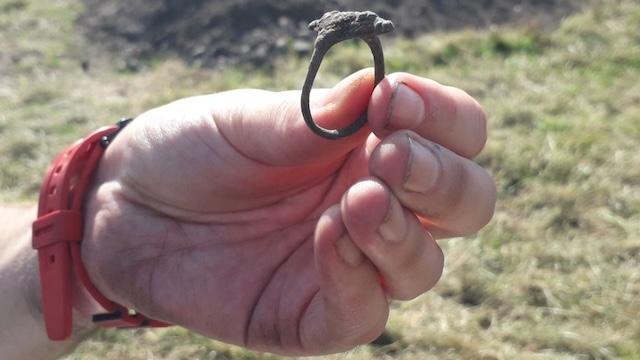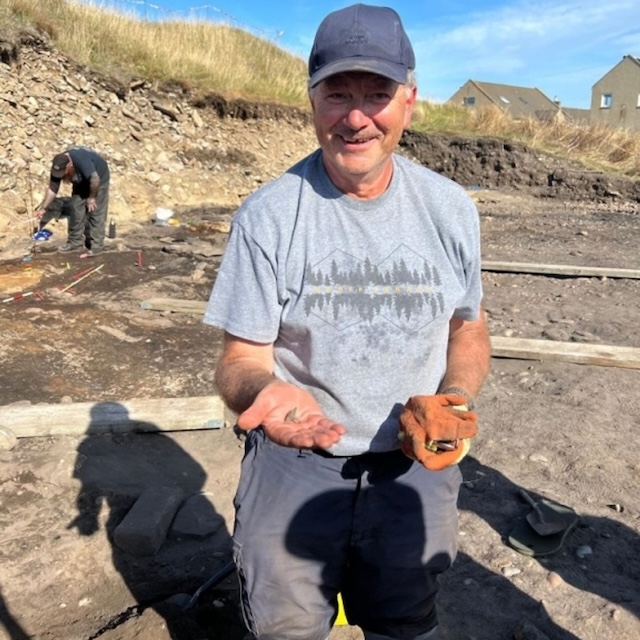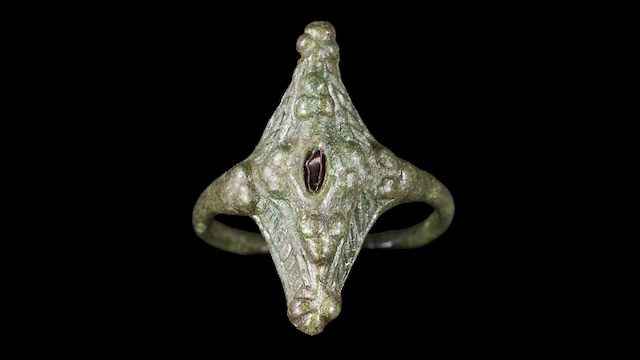An incredible discovery has been made during an archaeological dig at Burghead Fort in Moray, Scotland—a Pictish ring believed to be more than 1,000 years old. Unearthed by an amateur archaeologist, the ring, featuring a possible garnet or red glass centerpiece, offers a rare glimpse into the enigmatic Pictish civilization. This find not only sheds light on Scotland’s ancient past but also hints at the high-status craftsmanship that once thrived at Burghead.
A Remarkable Find at Burghead Fort
In a stunning discovery, a Pictish ring believed to be more than 1,000 years old has been unearthed during an excavation at the historic Burghead Fort in Moray, Scotland. The ring, which features a center of garnet or red glass, was discovered by John Ralph, an amateur archaeologist and volunteer working at the dig site. The find has been hailed as significant, shedding new light on the elusive and mysterious Picts, an ancient people who ruled parts of Scotland during the early medieval period.
Unveiling the Pictish Legacy
The Picts, who lived between 300 AD and 900 AD, are known for their fascinating but largely undocumented history. Little is known about their kingdoms or their way of life, as they left behind no written records. Instead, archaeologists rely on artifacts, such as the recently discovered ring, to piece together information about these ancient people. Burghead Fort has long been recognized as a Pictish site, but much of its historical significance was believed to have been lost when the town of Burghead was built over the ruins in the 1800s.
The Volunteer’s Thrilling Discovery
John Ralph, a retired engineer and University of Aberdeen graduate, signed up as a volunteer to assist with the University of Aberdeen-led excavation at Burghead Fort. Despite being told that most of his finds during the dig were nothing more than “shiny pebbles,” Ralph struck gold on the final day of the excavation. His discovery of the kite-shaped ring, with its garnet or glass centerpiece, was described as a “real thrill” as he became the first person to hold the ancient artifact in over a millennium.

“It’s amazing to think you’re the first person to see something like this in over 1,000 years,” Ralph said. “It sparks questions about who owned it, what it was used for, and how it was lost.”
A Glimpse Into the Pictish World
The ring is now being examined by experts at the National Museum of Scotland’s post-excavation service. Initial assessments suggest that the ring may have belonged to someone of high status, given the sophistication of its design. The discovery of the ring, along with evidence of buildings and other metalworking artifacts, adds to the growing picture of Burghead as a significant Pictish power hub.
Archaeologist Professor Gordon Noble, who has led the excavation work at Burghead for three years, described the ring as “truly remarkable.” He believes that the find provides important clues about the high-status production of metalwork at the fort, indicating that it was a significant seat of power during the Pictish period.
The Mystery of the Picts
The Picts were the descendants of the Iron Age people who lived in what is now Scotland, north of the River Clyde and the River Forth. Though they dominated much of Scotland during the early medieval period, their history remains shrouded in mystery. Much of what is known about their culture and society comes from archaeology, as none of their written records have survived the passage of time.
Despite the lack of written documentation, archaeologists have been able to piece together important aspects of Pictish life, particularly through their elaborate stone carvings, jewelry, and metalwork. The discovery of the ring at Burghead Fort is a significant addition to this body of knowledge, offering new insights into the craftsmanship and social hierarchy of the Picts.

Adding to the Puzzle of Burghead Fort
For John Ralph, the discovery of the ring has a personal resonance. He grew up in the Burghead area, where his ancestors had settled as part of the movement of people brought in to support the fishing industry during the construction of the new town. Reflecting on his discovery, Ralph said, “It’s good to think that I’ve given something back with this little piece of the puzzle of the past.”
The find also has broader implications for the study of Burghead Fort, which has long been recognized as one of the most important Pictish sites in Scotland. While much of the fort was destroyed during the construction of the town in the 1800s, ongoing excavations continue to reveal important artifacts and evidence of buildings, offering new insights into the fort’s significance.
A Growing Picture of Pictish Power
Professor Gordon Noble emphasized the importance of the find, noting that it adds to the growing evidence that Burghead Fort was a key center of power during the Pictish period. “We have uncovered several buildings and evidence of metalworking, and this ring is a further indicator of high-status production at the site,” Noble said. “Burghead was clearly a significant seat of power during the Pictish period.”
The University of Aberdeen’s excavation work at Burghead Fort, funded by Historic Environment Scotland, has been ongoing for the past three years. The discovery of the ring, along with other important finds, has prompted further research into the site’s significance and its role in Pictish society.
Public Engagement and the Future of the Dig
In the wake of this remarkable discovery, the Burghead Fort excavation team will host an open day to engage the public and share insights into the site’s history. Visitors will have the opportunity to learn more about the fort’s Pictish past and see some of the artifacts uncovered during the dig. The open day will take place on Sunday, from 10 AM to 4 PM.
The discovery of the Pictish ring is a reminder of the rich and complex history that lies beneath Scotland’s soil. As archaeologists continue to uncover new artifacts and pieces of the past, the picture of the enigmatic Picts becomes clearer, offering us a rare glimpse into a people whose legacy continues to captivate and intrigue.

Conclusion
The discovery of the 1,000-year-old Pictish ring at Burghead Fort adds a remarkable new chapter to the understanding of Scotland’s ancient history. The excavation, led by the University of Aberdeen, continues to unearth treasures that offer clues about the lives and craftsmanship of the Picts. With further analysis of the ring and the surrounding artefacts, archaeologists hope to reveal more about the site’s significance as a center of power during the Pictish period. This find not only highlights the rich cultural heritage of the region but also reminds us of the important role archaeology plays in connecting us to our past.
